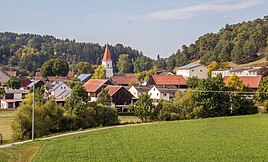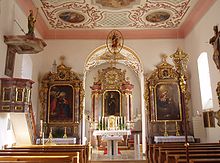Morsbach (Titting)
|
Morsbach
Market Titting
Coordinates: 49 ° 1 ′ 15 ″ N , 11 ° 15 ′ 8 ″ E
|
|
|---|---|
| Height : | 465 m above sea level NN |
| Incorporation : | January 1, 1972 |
| Postal code : | 85135 |
| Area code : | 08423 |
|
Place view
|
|
Morsbach is a district of the Titting market in the Upper Bavarian district of Eichstätt .
Geographical location
The village is located in the north of the Eichstätt district in the Morsbach valley , a water-rich left tributary of the Anlauter . The place can be reached from the federal highway 9 via the junction Greding (distance from the junction to Morsbach: 9.5 kilometers). Neighboring towns to which direct road connections lead from Morsbach are Emsing , Mantlach , Großnottersdorf and Grafenberg . A road connection, which is restricted to motorized traffic, leads to Esselberg . The closest railway connection is 16 kilometers away in Kinding .
history
A prehistoric burial mound field with eleven safe and several questionable mounds was found on the Fuchsberg near Morsbach ; one of the hills, opened in 1890, can be assigned to the Bronze Age based on finds .
The Lords of Morsbach , the "Morsbacher" or "Morsbecken", were seated in Morsbach as the Eichstätter ministerial family (see also list of Bavarian noble families # M ). Their rectangular castle , also known as the palace, surrounded by a moat , was located southeast of today's church.
The place is first mentioned in a document in 1075. In 1140, the Ministeriale Kuno von Morsbach handed his daughter over to the Weihenstephan Monastery for upbringing , which was still a double monastery until 1242, and presented her with an estate in Morsbach. Around 1156, Konrad I von Morsbach , who was the 24th Eichstätt bishop from 1153 to 1171, built an Augustinian canon monastery in " Rebedorf " near Eichstätt , where he was also buried. 1186 confirmed Pope Urban III. the Hochstift property and rights in Morsbach. In 1250, Count Gebhard (VI.) Von Hirschberg , guardian of the Eichstatt bishops, donated his Morsbach property to the German gentry in Ellingen .
In the dispute about the Hirschberg inheritance after the death of the last Hirschberg count, Gebhard VII., Morsbach was awarded to Eichstätt in 1305; in this context there is talk of a division into Ober- and Untermorsbach. Since the beginning of the 14th century, the Lords of Morsbach owned the Krugsburg am Kruspelberg in Altendorf im Gailachtal as an Eichstätter fief , which they sold in 1371 to the Eichstätt Monastery. In Eichstätt itself, the family owned a farm until the beginning of the 15th century, which Ulrich von Morsbach sold to the Bishop of Eichstätt in 1404.
After an inheritance division in 1446 as a result of the death of the last Morsbach aristocrat Kaspar I, the eight estates of "Obermorspach" were acquired in 1533 with all rights from the Heilig-Geist-Spital in Nuremberg , while "Untermorspach" became prince-bishop's property in 1550 under Bishop Moritz von Hutten was subordinated to the prince-bishop's office of judge Greding . The Nuremberg subjects of Obermorsbach became Protestant during the Reformation , but became Catholic again in 1649 through a treaty between Eichstätt and Nuremberg. Nothing changed in these conditions until secularization in 1802 and the transition to Bavaria in 1806.
As early as 1696 there was a school in Morsbach for the children from Morsbach, Mantlach , Esselberg and Großnottersdorf . Until the parish elevation in 1671, Morsbach belonged to the parish of Großhöbing . On June 17, 1885, the village and corridor of Morsbach were hit by a devastating storm with hailstorms , which went down in the history of the village.
In 1960 it was used as a vicarage from 1671, and in 1732 by Johann Rigalia the Elder. J. renovated the castle, demolished and made room for a new rectory. In 1964 land consolidation was carried out. As part of the regional reform , Morsbach was incorporated into the Titting market on January 1, 1972.
Attractions
- Church : In Morsbach, the Eichstätt Bishop Gundekar II consecrated a church in the 11th century (around 1060?). In 1671 Morsbach was raised to a parish, which also included Esselberg, Mantlach and Großnottersdorf. Less than three decades later, the church had to be demolished because it was in disrepair. From 1696 to 1701 today's Catholic parish church of St. Walburga was built as a baroque new building. The upper floor of the tower with its helmet instead of the previous hood dates from 1743. In 1776 the wooden ceiling was replaced by a white ceiling, and in 1851 and 1856 the church painters Waibel and Werner decorated the ceiling with pictures. In 1898 the church was expanded. In 1948 the tower received a new peal of three steel bells. In 1967 there was an exterior and interior renovation of the church. Inside are a viersäuliger rococo - high altar of 1760 with younger altarpiece of St. Walburga by Alois Süßmeier and other baroque and rococo furnishings, including busts of the diocese founders Willibald and Walburga from 1710. After the secularization, paraments were acquired from the former Notre Dame monastery in Eichstätt around 1810 . In 1996, a new people's altar, created by the Eichstatt sculptor Günter Lang , was consecrated. - The war memorial , which commemorates seven Morsbachers who died in the First World War , dates from 1923.
- The Pfarrstadel , built in 1672, consists of plastered quarry stone masonry with a lime slab roof , just like the town still has a number of slate-covered Altmühl - Jura buildings , some of which are half-timbered .
Others
Population development: 1706: 28 families; 1808: 27 families; 1833: 133 inhabitants; 1912: 161, 1938: 153, 1950: 184, 1973 at the time of incorporation: 155 inhabitants.
There is a mill and farm shop in the still active “Hainmühle” on the northeastern edge of the village. Every year at Pentecost, a mill festival is celebrated on the mill premises.
The Catholic parish of St. Walburga is subordinate to the pastor of Titting. The last ordinary pastor left the parish in 1991. Since then, a foreign clergyman has lived in Morsbach as a chaplain for a few years . In 2000 the parish made a pilgrimage to St. Salvator in Bettbrunn for the 300th time, following a pledge made during the plague in the 14th century.
In March, the Morsbach brotherhood “Seven Sorrows of Mary”, founded in 1711, celebrates its annual brotherhood festival as the main festival of Morsbach.
In 1966 for the Education Association Morsbach, Mantlach , United Notter village and nettle mountain built, 1,984 abandoned vierklassigen school operates the Kreisjugendring Eichstaett a youth to stay home.
Village life is shaped by the Anlautertal fruit and horticultural association founded in 1903 , the Morsbachtal shooting club , a warrior and comradeship association from 1921 and the Morsbach church choir established in 1987. The place has an inn with an accommodation facility.
Morsbach has a village song composed by Rector Thomas Eff († 2005), which can be heard at all-village gatherings.
literature
- From old files of the Morsbach parish . In: Heimgarten 21 (1950), No. 30, 31
- The nobles of Morsbach . In: Heimgarten 22 (1951), No. 46
- The district of Eichstätt in history and present , Eichstätt 1973, p. 231f., 2nd edition 1984, p. 248 (with further references)
- Titting. Contributions to the natural and cultural history of the middle Anlautertal , Kipfenberg: Hercynia 1999, pp. 171–176, 305–309
Individual evidence
- ^ Wilhelm Volkert (ed.): Handbook of Bavarian offices, communities and courts 1799–1980 . CH Beck, Munich 1983, ISBN 3-406-09669-7 , p. 482 .
- ↑ Zur Linde website , accessed on November 13, 2012




